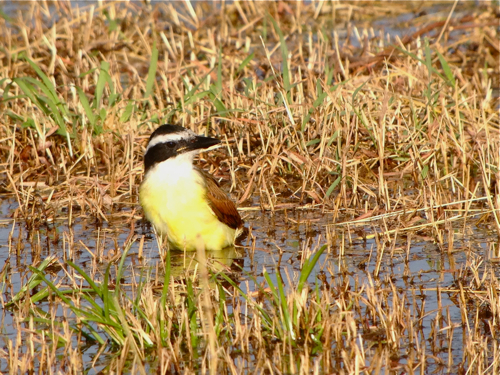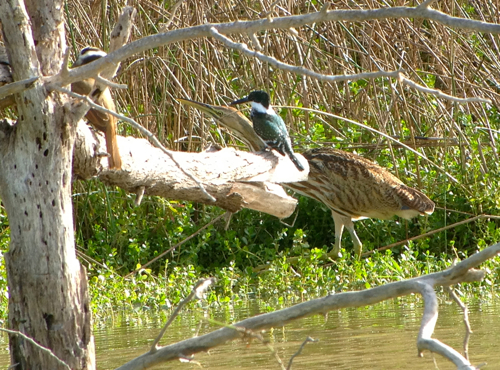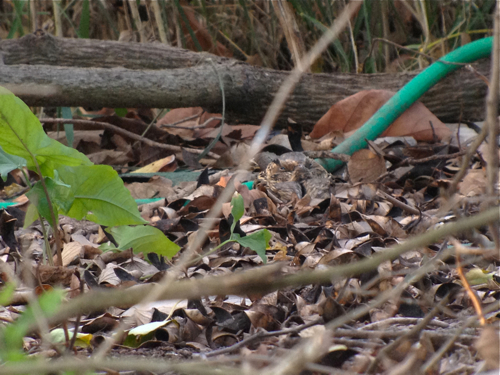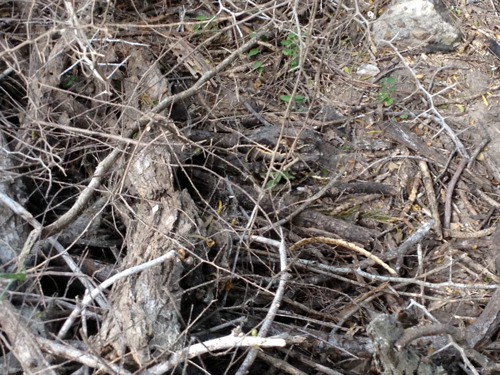I'm going to start this post off with landscape shots that have a brown bird called a common pauraque in them. See if you can find the bird(s) and at the end of the post, I'll put up the photos pointing out where they are and you can see if you were able to find them.

Let's start with an easy one, there's one common pauraque in this photo.

There's one pauraque in this photo.

There's one pauraque in this photo.

This is the hardest one, but there sure is a pauraque in this photo.

There are actually 2 pauraques in this photo, one easy...one almost impossible.
Most of my birding time during the Rio Grande Valley Birding Fest was spent at Estero Llano Grande State Park. Partly because I love it but also because some of my other favorite birding sites in the area were closed due to flooding. I went there several times with both Birdspot and WildBird on the Fly. One of the target birds on the trails is a common pauraque, a nightjar that is similar to nighthawks and whip-poor-wills. I've heard them and I've seen them flushed on roads at night in Central America, but I've never seen a roosting pauraque.

I knew people were seeing between 1 - 3 at a time and I was hopeful we'd find more than one. We sure did, above is one of the pauraques. With that cryptic brown plumage, you can understand how they might be easy to miss. They are active at dawn and dusk and fly around to catch insects with their mouths wide open. Don't let that tiny beak fool you, it belies a mouth worthy of any mother-in-law.

The park rangers and other birders were very helpful to point out the general areas of where the nightjars were being seen, but you still had to some work. Here's the trail near alligator lake where they typically have been found roosting. Note the white sign, it warns people to stay on the trails so the pauraques do not get flushed. Note the pile of brush on the left side of the trail, that's where the pauraques were. I suspect the brush was placed there to encourage people to stay on the trail and not wander in looking for the birds and inadvertently flushing them.

Check it out: Disapproving Pauraque! We found one right away and I was happy for that. These nightjars were a challenge to digiscope. Number one: they were in the shade. I could get around that by using the timer on my camera and minimize camera shake for a long exposure. However, the second and the most challenging problem was that the birds were too darned close to focus in my spotting scope! The sticks that were protecting the pauraque roosting location blocked some angles and I wasn't about to move the sticks, they were there to help the pauraques. But with patience and creative angling, I managed to grab some shots.

As I was setting up the above digiscoped shot, I found a second and then a third, each closer than the last. The third pauraque we found was literally three feet away from the trail. Finding the pauraques reminded me of morel hunting. Once you find one, you instantly see all the other mushrooms surrounding you. It was the same with pauraques, once you found one, the other popped out like an image in a magic eye painting.

Many of the pauraque photos like the above bird were not digiscoped because they are just too close. I always wonder how many owls I pass under on a regular basis, not I wonder how many pauraqes, poor-wills and other nightjars I have almost stepped on in my birding travels. The pauraques did seem to be everywhere in South Texas. Birdspot and I were wandering around Frontera Audubon, watching a brown thrasher that was working some leaves, when all three of us--especially the thrasher jumped with a leaf toss flushed a pauraque. I wonder how often other birds flush nightjars. And I wonder if they are irritated because of the scare?
And now to see how you did with finding the pauraques in the first five photos:

Here's common pauraque number one. This one may have been too easy, that eye sticks out. But I walked past it at least twice before I finally realized it was three feet from the trail.

Hidden pauraque #2.

Pauraque nestled all snug among sticks.

I realize that even though it's circled, this pauraque is hard to see, so here is a zoom in of the cryptically plumaged nightjar:

Even up close, you can see how well their feathers work in their habitat!

The one in the front is fairly obvious, but the one in the back is really hard to see. Here's a close up:

See, there really is a parauque by those sticks!
Ah, nothing makes me as happy as looking for brown birds!























